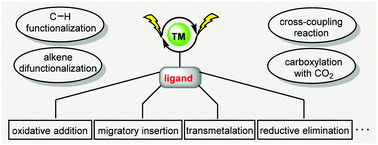An electrochemical perspective on the roles of ligands in the merger of transition-metal catalysis and electrochemistry
Abstract
The merger of transition-metal catalysis and electrochemistry has emerged as a very versatile and robust synthetic tool in organic synthesis. Like in their non-electrochemical variants, ligands also play crucial roles in fundamental reactions in transition-metal catalysis under electrochemical conditions. Herein, a perspective on the roles of ligands in transition-metal catalysis under electrochemical conditions is provided with selected transformations enabled by such a merger including C–H functionalization, difunctionalization of alkenes, cross-coupling reactions and carboxylation with CO2.

- This article is part of the themed collection: 2021 Organic Chemistry Frontiers Review-type Articles


 Please wait while we load your content...
Please wait while we load your content...